For our project, our group used Doris Zhang’s artifact concept, based off of “The Ones Who Walk Away From Omelas”. The artifact concept was one of a mirror, specifically responding to the behavior of the citizens of Omelas towards the sad child in the basement that keeps their city peaceful and happy.
The mirror was designed to force the citizens who looked into to empathize more with the sad child and reflect on their behavior, by changing their reflection into one of the sad child’s. The artifact interacts with the viewer by taking in their reflection and morphing it based on the view themself, thus provoking a new reaction from the viewer. My own personal definition of interaction is “a state where a subject or party can be changed by or respond to the actions of another”, which definitely fits with the mirror’s capabilities.
Our group had exactly three work sessions. We communicated through a Slack channel at first, then switched to a Wechat group to organize meeting times. During the first session, we brainstormed ideas by sharing our “Read” concepts, then narrowed down the best option to make and perform. Based on the selected artifact, we then made a rough outline of what to perform and what roles each of us would play. We then scheduled two more sessions, one to make, the other to rehearse. Our make session was on Tuesday, during/after the cardboard workshop. Because I had class during the workshop, I arrived later than some of the others. Once I got there, the team already had a sketch of the mirror and the general idea of how to build it.
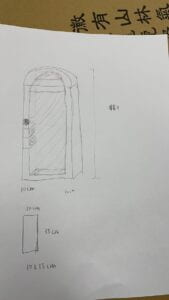
Because it was such a large and relatively simple design, most of the work was fairly repetitive and easy to divide. Essentially, we had one or two team members cutting out rectangles of cardboard while the rest of us scored, rolled, and hot glued the pieces together. I personally was in the latter team of people.
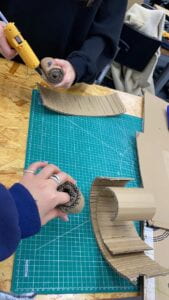
After making the main frame, we added more thin pieces of cardboard to the back as support, since the rolls alone were rather wobbly. Because of its size, the exact contributions each of us made seems a bit blurred — there were always multiple people working on it at the same time, helping hold the piece up, discussing potential issues, gluing and regluing, etc.
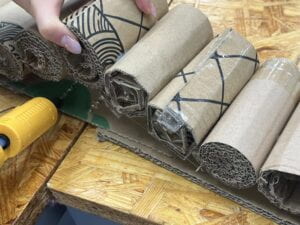
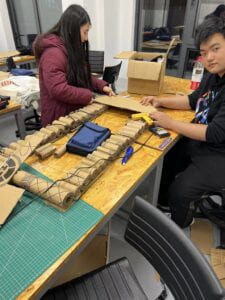
We couldn’t make the mirror full-length, since we had made the base a bit too narrow and there likely wouldn’t be enough support. As such, we spent some time brainstorming ways to prop the mirror up. We had settled on a vague idea of putting the mirror on a chair and having our team sit on chairs during the performance as well, but thankfully, we found an alternate solution. A leftover cardboard box was large enough for the mirror to be placed on and cut off relatively little of our “reflections”, so we added the box to our performance as well.
The next session, we finished up the mirror by building a simple support that allowed it to stand by itself, using cardboard, hot glue, and masking tape. We then decorated the mirror and box with some pastels Doris provided (thanks, Doris).
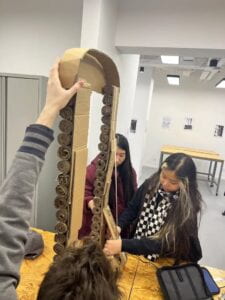
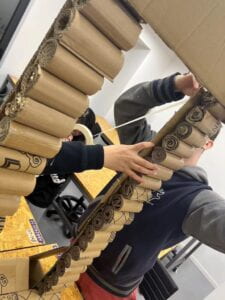
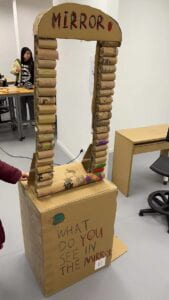
Afterwards, we moved onto rehearsal. Our roles were somewhat separate roles in the performance: mirror-keeper (me), viewer/reflection set 1, viewer/reflection set 2. As such, each mini-group more or less had their own performance. The script on our group document reads as follows:
Notes I add on will be marked with (Note:)
Script:
- 0-30s (Note: “0-30s” was an original plan for mapping out the script based on timestamps. As seen with the lack of further timestamps, this did not follow through)
- Intro the mirror
- Dramatic reveal (Note: In the oldest version of our plan, I think we planned to have a cloth covering the mirror that would be yanked off. This did not make it into the performance)
- ntro speech [sic]
- Person interrupts (Note: The interrupting didn’t make it into the final either) > starts looking in mirror
- Two pairs of actors looking in the mirror, 1 as viewer, 1 as reflection
- pair 1 sees mirror change, expresses fright/discomfort/shock, pair 2 has deep reflection
- Intro the mirror
As you can see, our group script is very sparse. After we ran through the performance once, we found a few problems:
- When to transition between regular reflection and sad child
- How to keep the reflection shenanigans fresh
- How to show the change and followed horror
The solution we came up with for the third problem was for our actors to monologue throughout their section to better inform the audience. For problems one and two, we decided to have each mini-group work on their own section to straighten out the details.
A very brief clip of an early rehearsal:
I wasn’t part of the reflection/viewer pairs, so I mostly just had fourth-wall monologues to work on. Since I had a solid idea of my opening and my character’s purpose, I decided to improvise my monologues (did come back to bite me in the beginning of the performance, but for the most part I think it worked out). Doris and Maggie worked on their section, which I want to give huge props to—it added so much character, clarity, and smoothness to the whole performance (Thanks, Doris and Maggie). Meanwhile, Sean, Aidan, and I re-rehearsed the second half of the scene, which mostly boiled down to defining Sean’s main tone of interaction with the mirror-keeper (mean-spirited) and Aidan’s method of portraying the sad child. After our individual section work, we came back together and ran it through a few times from the top. In these last few runs, we figured out cues and mirror-keeper/viewer/reflection interactions. Once those aspects were figured out, we called it a day and waited to perform.
In terms of the artifact’s physical design, I think it worked much better than I expected. I think the overall design is nice and the mirror is surprisingly structurally sound. I do think that its resemblance to an actual mirror is somewhat limited, but I also think the performance (and the giant “MIRROR” written on top of it) makes up for the slight lack in physical similarity. In terms of the artifact as an actual invention in the world of Omelas, I think there’s two main questions about it: one, is it effective, and two, is it moral? Obviously, the citizens would have some form of horrified reaction, but the reaction may merely traumatize them and not necessarily drive them to leave the city. If it is successful, there’s also the question of whether its goal was moral or not. If we’re to look through an utilitarian perspective, there is the potential argument that the mirror is merely causing emotional harm to the citizens while not necessarily bringing anyone joy, and is therefore immoral. From this point of view, it can be said the mirror fails to be morally good or completely effective, as it’s designed to. However, from another point of view, the mirror would also guarantee people to understand the sad child more closely and reflect, which means its ultimate purpose is still fulfilled.
For my analysis of a second group, I decided to focus on team Explorer. This team made several artifacts based on the story “The Plague”. Among these artifacts, there were: a helmet that created a plague-resistant forcefield, a plague detecting device, a plague-progression scanner, a heartbeat monitor, and an eye-writing tool that let the victim express their last wish and transport them to a corresponding digital world. I feel the larger devices (helmet and eye-writer) were a bit hard to understand without performance, but the smaller ones were very clear, especially as their designs seemed to be based on real-world objects. I think all the artifacts are very relevant to their story’s world, since they’re all specifically dealing with managing the plague. Some of the artifacts fit very well with the prompt, however, a few don’t seem very interactive. The eye-writer is clearly interactive, especially since it’s based on the actual eye-writer which was used as an interactive device example. The plague detecting device, progression scanner, and heartbeat monitor all fit into my definition of interaction, since they are changing based on the person. However, I don’t think the helmet really counts as an interactive device, since it only provides a shield and doesn’t react to its environment. The performance also was very cohesive and showed all the purposes of the artifacts while naturally integrating it into the plot. I think the performance could be improved by focusing more on the most interactive devices and clarifying its capabilities, but in general, I think the pieces and their concepts were well executed.